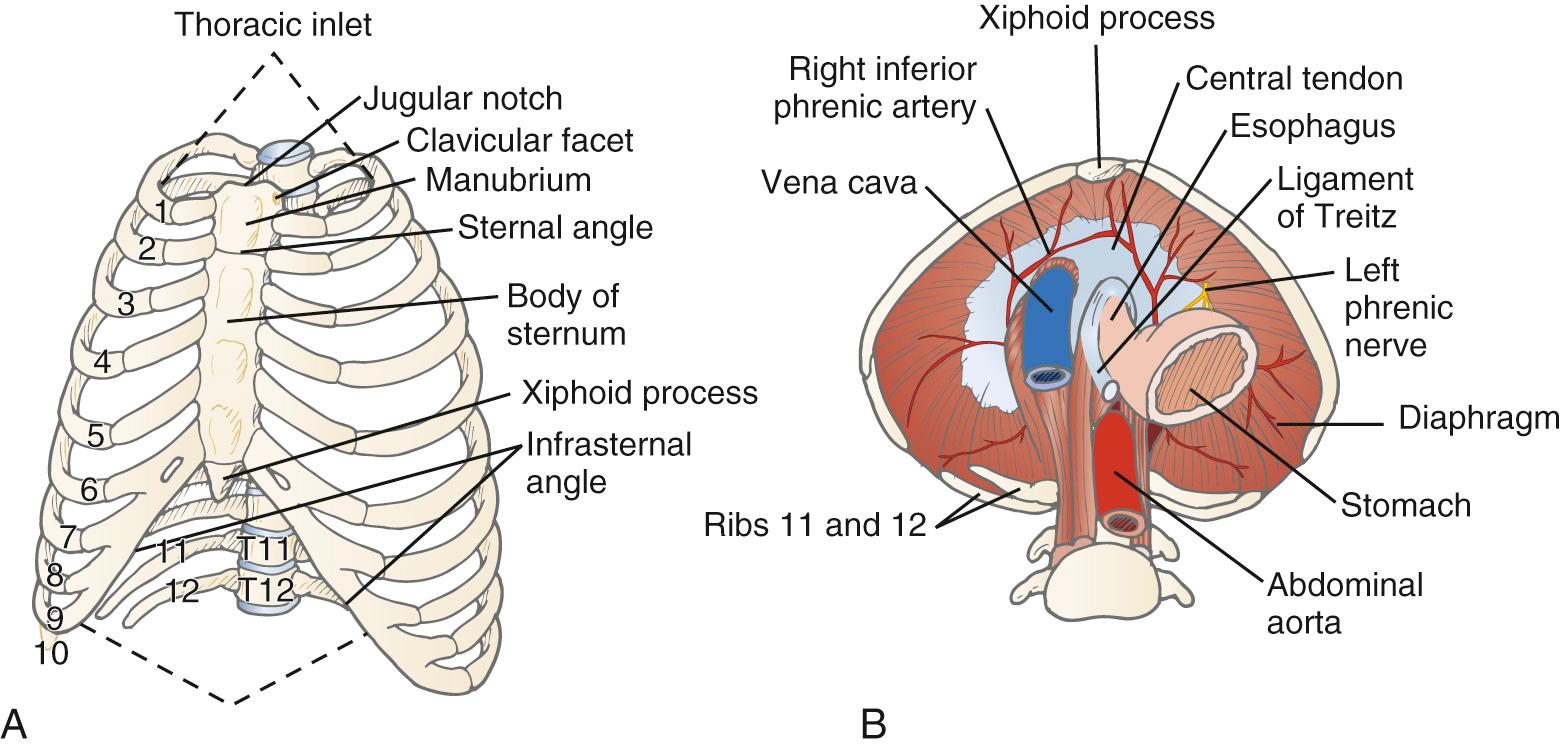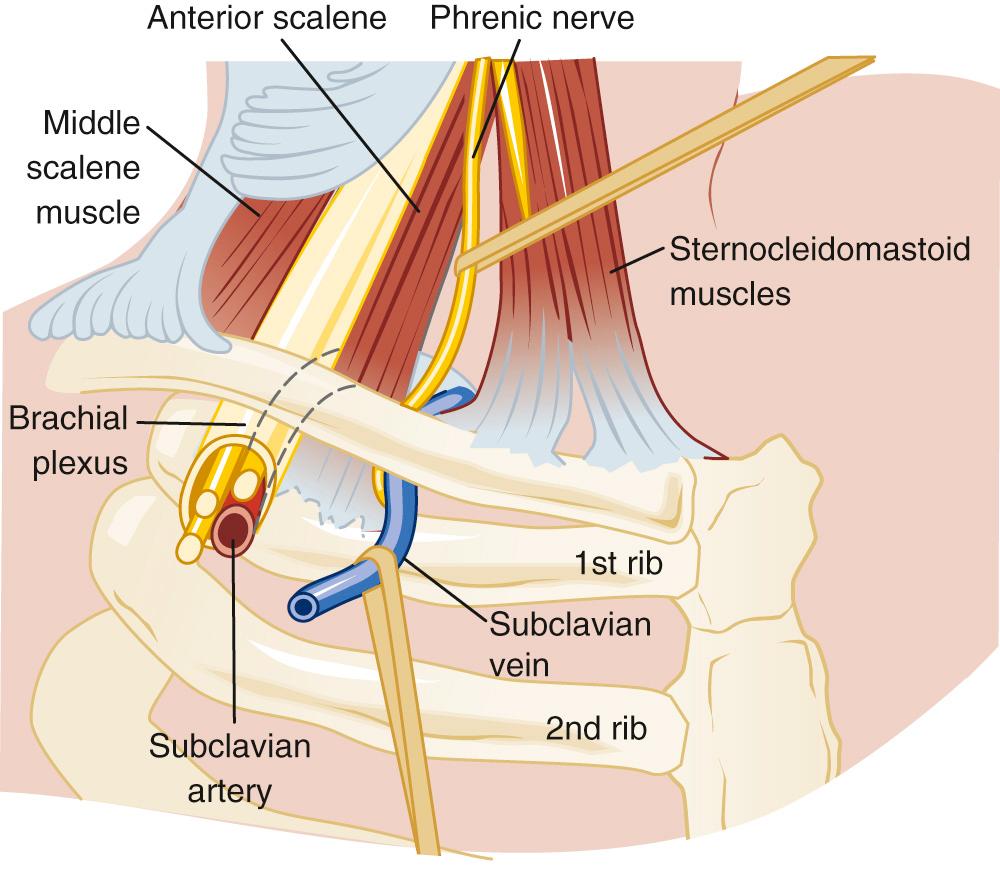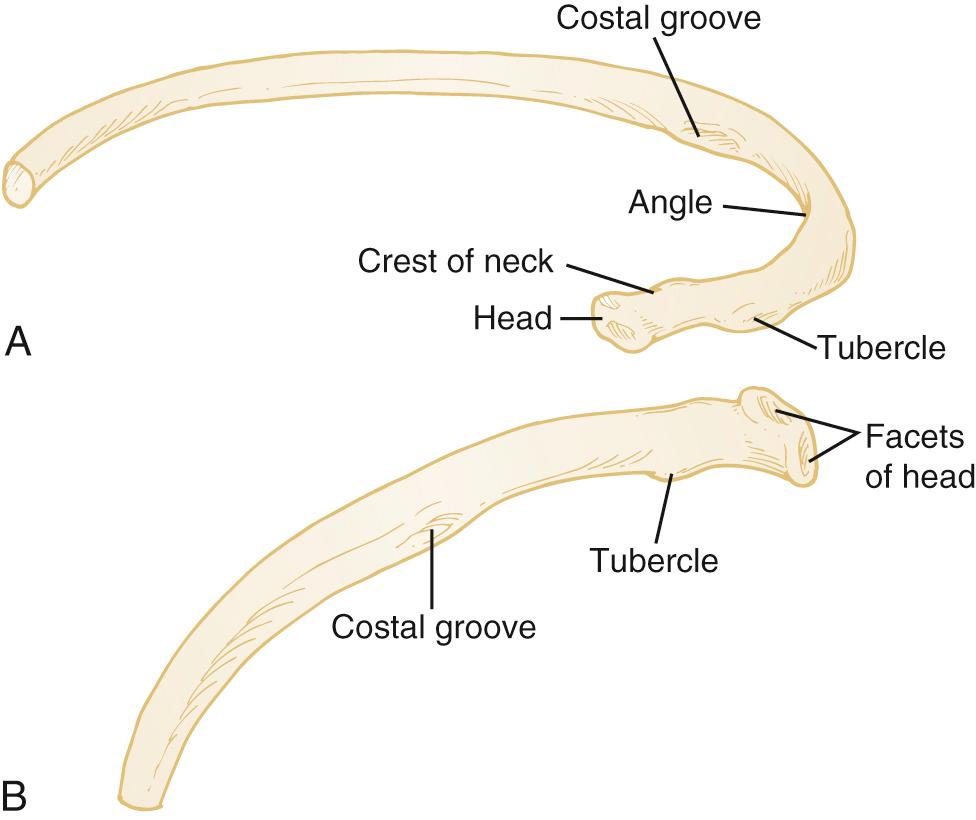Physical Address
304 North Cardinal St.
Dorchester Center, MA 02124
The thorax is the upper part of the trunk, bounded by the diaphragm inferiorly, the thoracic inlet superiorly, and the thoracic cage between. Vital organs, such as the heart and lungs, reside completely within the thoracic cavity, and other, equally vital organs, such as the aorta and esophagus, extend into the abdominal cavity. The thorax can be divided into a right and left hemithorax, separated by the mediastinum. This chapter gives an overview of the anatomy of the thoracic cavity and its contents.
The cylindrical thoracic cage has two main purposes: it provides protection for the underlying organs, and the dynamic interactions of the bony and muscular components of the chest wall allow changes in respiratory volumes.
The bony thorax has two apertures, or openings: the superior thoracic aperture, often referred to as the thoracic inlet or cervicothoracic junction, and the inferior thoracic aperture ( Fig. 1-1 A ).

The thoracic inlet is limited by the body of the first thoracic vertebra posteriorly, the first pair of ribs and their costal cartilages anterolaterally, and the superior border of the manubrium anteriorly. Many important structures travel through the cervicothoracic junction. Resection of malignancies (e.g., Pancoast tumor) or repair of thoracic outlet syndrome requires intimate knowledge of the anatomic relationships in this area. In this kidney-shaped inlet, the trachea is midline and behind the great vessels, and the esophagus is posterior and slightly to its left. The innominate artery arises from the aortic arch and passes posterior to the manubrium and anterior to the trachea as it travels cephalad. The right and left internal jugular and subclavian veins join behind their respective sternoclavicular joints to form the left and right brachiocephalic veins. The left brachiocephalic vein travels right to join its counterpart to form the superior vena cava. The main muscles of this region are the sternocleidomastoid and scalene muscles, and the main nerves form the brachial plexus, but the phrenic and vagus nerves also pass through this aperture.
As the margin of the aperture slopes inferoanteriorly, the apex of each lung and its covering pleura (pleural cupola) project superiorly through the lateral parts of the thoracic inlet and are covered by a piece of cervical fascia, the suprapleural membrane (Sibson fascia).
The cervicoaxillary canal is bounded by the first rib inferiorly, the clavicle superiorly, and the costoclavicular ligament medially ( Fig. 1-2 ). The structures that pass through this space include the subclavian vein and artery and the brachial plexus.

The subclavian artery passes over the first rib and goes between the scalenus anterior and scalenus middle muscles. Before passing over the first rib on its way out of the cervicoaxillary canal, the subclavian artery gives off branches, including the thyrocervical, internal mammary, and vertebral arteries. It becomes the axillary artery after it exits from behind the pectoralis minor muscle. Compression of this artery can lead to poststenotic dilation, stenosis, aneurysmal formation, or occlusion.
The subclavian vein travels from the arm and goes behind the pectoralis minor muscle before going between the first rib and clavicle. This space is bounded medially by the costoclavicular ligament and laterally by the scalenus anterior muscles as it inserts onto the first rib. Compression of the vein occurs in this area and can lead to stenosis and occlusion.
The brachial plexus is composed of nerve roots from the C5 through the T1 vertebral foramina. These nerve roots join to form the superior trunk (C5 and C6), the middle trunk (C7), and the inferior trunk (C8 and T1). These trunks separate into anterior and posterior divisions that fuse again to form lateral, medial, and posterior cords of the brachial plexus. The plexus travels through the tunnel formed by the anterior and middle scalene muscles. It travels between the first rib and the clavicle and finally under the pectoralis minor muscle to gain access to the arm.
In the normal anatomy, there is ample room for each of these structures. There are four major areas in which the vessels or nerves can be compressed ( Table 1-1 ).This topic will be discussed in detail in Chapter 26 .
| Site | Description | Abnormalities | Structures Compressed |
|---|---|---|---|
| Sternal-costovertebral circle | This aperture can be narrowed by bony variations |
|
|
| Scalene muscle triangle | The scalenus anterior and middle muscle insert on the first rib, creating a tunnel | Scalenus anterior and middle |
|
| First rib, clavicular space | The neurovascular structures lie above the rib and below the clavicle |
|
|
| Behind the pectoralis minor muscle | The neurovascular structures travel to and from the arm behind this muscle |
|
|
The diaphragm, at the inferior thoracic aperture, separates the thoracic cavity from the abdominal cavity. The inferior thoracic aperture, which slopes inferoposteriorly, is limited by the 12th thoracic vertebra posteriorly, the 12th pair of ribs and costal margins anterolaterally, and the xiphisternal joint anteriorly.
The diaphragm is a curved, musculotendinous sheet that is mainly convex toward the thoracic cavity. It is a continuous sheet of muscle with low posterior and lateral attachments and high anterior attachments. The central tendon is a thin but strong aponeurosis. The domes of the diaphragm descend 2 cm during quiet respiration and can travel as much as 10 cm during heightened respiratory requirements. During expiration, the right diaphragm can rise as high as the level of the nipple, whereas the left rises to a level one rib space lower. With maximal inspiration, the diaphragm flattens against the abdominal contents. The right diaphragm can flatten to the level of the 11th rib, whereas the left can flatten to the level of the 12th rib. The right diaphragm has to work against the liver, whereas the left needs to push only against the stomach and spleen; therefore, the right diaphragm has significantly stronger fibers than the left.
The costal diaphragm receives its blood supply from the lower five intercostal and subcostal arteries, and the central portion is supplied by the phrenic arteries. The phrenic arteries can arise directly from the aorta, above the celiac axis, as a common trunk or individually. Occasionally, they arise from the celiac or renal arteries. The sole motor supply to the diaphragm is the phrenic nerve. It also supplies sensory fibers to the parietal and peritoneal pleura overlying the diaphragm; this accounts for the diaphragmatic irritation that is sometimes interpreted as ipsilateral shoulder pain.
The diaphragm has several openings through which structures can transverse from one cavity to another (see Fig. 1-1 B ). The inferior vena cava hiatus lies anteriorly and to the right of the midline, at the level of vertebra T8. The right phrenic nerve travels through this hiatus, and the left phrenic nerve penetrates laterally through its own opening at the same level. The esophageal aperture is at the level of the T10 vertebra, and the right and left vagal trunks that adhere to it enter the abdomen along with the esophagus.
The aortic aperture, at the T12 vertebral level, is formed by the interdigitating fibers (median arcuate ligament) of the right and left diaphragmatic crura. The azygos and hemiazygos veins and the thoracic duct also pass through this opening.
The greater and lesser splanchnic nerves gain access to the abdominal cavity via two small apertures in each of the crura, and musculophrenic branches of the internal mammary artery penetrate the diaphragm through small apertures near its connection with the costal cartilages of ribs seven to nine.
Diaphragmatic hernias can develop through known openings, such as a hiatal hernia through the esophageal hiatus, or through congenital defects. The most common congenital abnormality is a Bochdalek hernia, in which abdominal contents go through a posterolateral defect. This abnormality is seen more commonly on the left side. A Morgagni hernia, however, occurs with a defect in the anterior aspect of the diaphragm just lateral to the xiphoid.
The sternum or breastbone is made of cancellous bone and filled with hemopoietic marrow throughout life. The main parts, the manubrium and body, are connected by a secondary cartilaginous joint that normally never ossifies and contributes to movement of the ribs.
Up to puberty, the six segments, or sternebrae, are held together by hyaline cartilage. The central four segments fuse to form the body of the sternum between 14 and 21 years of age. The manubrium sterni (superiorly) and the xiphoid process (inferiorly) remain separate.
The manubrium receives the sternal ends of the clavicles in a shallow concave facet. The widest portion of the manubrium has bilateral costal incisurae that articulate with the first costal cartilage to form a primary cartilaginous joint. The second costal cartilage articulates with both the lower lateral ends of the manubrium and the body of the sternum, forming separate synovial joints. The muscular attachments of the manubrium include the sternocleidomastoid muscle, the sternohyoid and the sternothyroid superiorly, and the pectoralis major muscle anterolaterally. Most of the posterior surface is bare bone, which can be in contact with the brachiocephalic vein unless thymic remnants lie between.
The gladiolus, or body of the sternum, is slanted at a steeper angle than the manubrium; its articulation with that bone forms the sternal angle. Ossification of this joint, synchondrosis, in adult life can limit normal movement at this joint. The articular facets for ribs two to seven lie along the lateral border of the body of the sternum. These make single synovial joints with the costal cartilages. The facets for the sixth and seventh costal cartilages can coalesce, especially in females. The lateral border gives attachment to the anterior intercostal membrane and the internal intercostal muscles, and the pectoralis major arises anteriorly. Weak sternopericardial ligaments pass into the fibrous pericardium.
The cartilaginous xiphoid may be bifid or perforated, is of variable length, and usually ossifies in the fourth decade of life. The costoxiphoid ligaments prevent its displacement during diaphragmatic contractions.
The 12 pairs of ribs are divided into the upper seven, which are called true ribs or vertebrosternal ribs because they form complete loops between the vertebrae and the sternum, and the lower five ribs, which fail to reach the sternum and are considered false ribs. The 8th, 9th, and 10th ribs are called vertebrocostal because each of their costal cartilages articulates with the adjacent rib cartilage. Ribs 11 and 12 are free-floating or vertebral ribs because their only articulation is with their vertebrae.
Ribs three to nine are classified as typical ribs and have a head, neck, and a shaft. The head has an upper and a lower articular facet divided by a crest for articulation with two adjacent vertebrae in synovial costovertebral joints, the lower facet articulating with the upper border of its own vertebra. The neck is flattened, with the upper border curling up into a prominent ridge—the crest. A tubercle projects posteriorly from the end of the neck and marks the junction of the neck and the body ( Fig. 1-3 ).

Become a Clinical Tree membership for Full access and enjoy Unlimited articles
If you are a member. Log in here